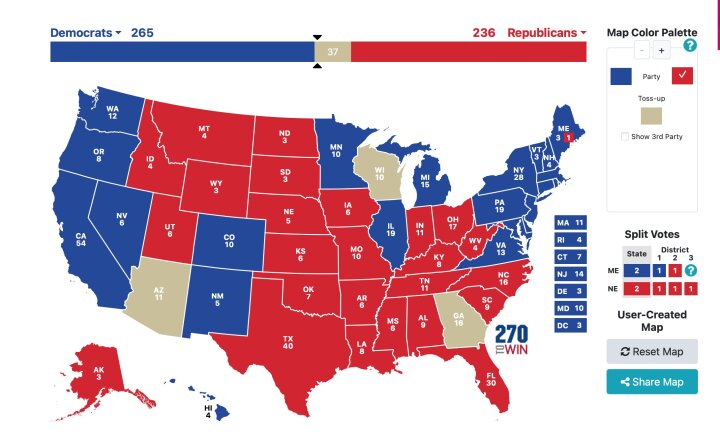A very early look at the Electoral College for 2024
For better or worse (actually, definitely worse), only five states really matter for the 2024 presidential election. They are Wisconsin, Michigan, Pennsylvania, Arizona, and Georgia. All of them went for Donald Trump in 2016 but all turned blue in 2020. The other states pretty much always vote the same way and are very predictable, although under the right circumstances, Nevada, New Hampshire, and North Carolina could be in play.
The 2016 results in two of the states, Michigan and Pennsylvania, are really anomalies. Since 1992, both have been reliably blue states. The 2016 election is the only time since 1988 a Republican has won either one, and then only by a hair. Trump won Michigan in 2016 by 10,704 votes out of 4.80 million (0.23%). He won Pennsylvania by 44,292 votes out of 6.2 million (0.72%). In contrast, in 2020 Joe Biden won Michigan by 154,188 votes out of 5.54 million (2.78%) and Pennsylvania by 80,555 votes out of 6.94 million (1.16%). Barack Obama won Michigan by 8 points in 2012 and 16 points in 2008. He won Pennsylvania by 5 points and 11 points, respectively. That's more normal.
So for the moment, let's assume Michigan and Pennsylvania stay blue, especially since both elected a Democratic governor in 2022 by double digits. That gives us this tentative Electoral College map for 2024, baring something very unusual:
The first thing to notice is that the Democrats are at 265 (261 if they really manage to kick New Hampshire out of first place in the primaries and the voters take revenge on them). That leaves the blue team 5 (or 9) EVs short of 270, with three swing states in play. All three have at least 9 EVs. That means that the Democrats have to win only one of them to win. The Republicans must win all three (or flip some state not really in play). All three will be truly massive battlegrounds.
Arizona and Wisconsin will be especially in play due to hotly contested Senate elections. Sen. Kyrsten Sinema (I-AZ) and Sen. Tammy Baldwin (D-WI) are up in 2024. In Arizona, especially, Democrats hate Sinema and are likely to turn out in huge numbers to vote for the actual Democrat in the race, probably Rep. Ruben Gallego (D-AZ), although he could yet pull a primary challenger.
These observations are largely independent of whether Biden runs again and of who the Republican nominee is. If Gov. Ron DeSantis (R-FL) is the nominee, that might give him an edge in neighboring Georgia, but is more likely to hurt rather than help in Wisconsin, where working-class voters may not love him as much as they love Trump.
In short, while there is a huge amount of attention to who will be the nominees, keep in mind that it is the Electoral College that matters and the patterns there tend to transcend who the candidates are.
https://www.electoral-vote.com/evp2023/Items/Feb16-3.html
The 2016 results in two of the states, Michigan and Pennsylvania, are really anomalies. Since 1992, both have been reliably blue states. The 2016 election is the only time since 1988 a Republican has won either one, and then only by a hair. Trump won Michigan in 2016 by 10,704 votes out of 4.80 million (0.23%). He won Pennsylvania by 44,292 votes out of 6.2 million (0.72%). In contrast, in 2020 Joe Biden won Michigan by 154,188 votes out of 5.54 million (2.78%) and Pennsylvania by 80,555 votes out of 6.94 million (1.16%). Barack Obama won Michigan by 8 points in 2012 and 16 points in 2008. He won Pennsylvania by 5 points and 11 points, respectively. That's more normal.
So for the moment, let's assume Michigan and Pennsylvania stay blue, especially since both elected a Democratic governor in 2022 by double digits. That gives us this tentative Electoral College map for 2024, baring something very unusual:
The first thing to notice is that the Democrats are at 265 (261 if they really manage to kick New Hampshire out of first place in the primaries and the voters take revenge on them). That leaves the blue team 5 (or 9) EVs short of 270, with three swing states in play. All three have at least 9 EVs. That means that the Democrats have to win only one of them to win. The Republicans must win all three (or flip some state not really in play). All three will be truly massive battlegrounds.
Arizona and Wisconsin will be especially in play due to hotly contested Senate elections. Sen. Kyrsten Sinema (I-AZ) and Sen. Tammy Baldwin (D-WI) are up in 2024. In Arizona, especially, Democrats hate Sinema and are likely to turn out in huge numbers to vote for the actual Democrat in the race, probably Rep. Ruben Gallego (D-AZ), although he could yet pull a primary challenger.
These observations are largely independent of whether Biden runs again and of who the Republican nominee is. If Gov. Ron DeSantis (R-FL) is the nominee, that might give him an edge in neighboring Georgia, but is more likely to hurt rather than help in Wisconsin, where working-class voters may not love him as much as they love Trump.
In short, while there is a huge amount of attention to who will be the nominees, keep in mind that it is the Electoral College that matters and the patterns there tend to transcend who the candidates are.
https://www.electoral-vote.com/evp2023/Items/Feb16-3.html



